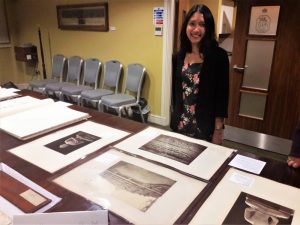Antiquities of Java
This week, Aria Danaparamita, our second Alphawood intern student shares her experience of working with our Collections:
~ ~ ~
As a student and researcher of Southeast Asian history and art, it was an honour for me to have the opportunity to intern at the Royal Asiatic Society, a leading institution and archive of Asian materials. Having recently completed my MA at SOAS University of London, I am very grateful that the RAS, the Southeast Asian Art Academic Programme at SOAS, and the Alphawood Foundation made this internship possible.
I contributed to an ongoing and important effort by the Society to make their collections available to a broader, digital audience. I spent nine weeks auditing and researching the Society’s visual materials on Southeast Asia, and adding records onto the RAS’ expanding digital database. Throughout, I was fortunate to have the generous guidance of RAS librarian Ed Weech and archivist Nancy Charley, who patiently mentored me through the practical and conceptual challenges of cataloguing and managing a collection.

Under Ed and Nancy’s guidance, I researched and catalogued two collections related to Javanese antiquities. The first was a series of photographs commissioned by the Batavian Society of the Arts and Sciences that documented the architecture, statues, and reliefs at various temples in Java. Photographed by Bruges-born engraver Isidore van Kinsbergen, the “Antiquities of Java” is a valuable collection, comprising some of the first photographic records of Borobudur, the 9th-century Buddhist monument and UNESCO World Heritage Site. I then curated photos from that collection and crafted labels for an exhibition display as part of the RAS Collections Open Evening on 21 November 2017.

The second collection was ‘Java Sketches’ in the Baker Collection, consisting of drawings and engravings of Hindu and Buddhist sites and objects. The drawings were either produced or collated by Lieutenant Colonel Godfrey Phipps Baker. A soldier, stationed in Java during the British interregnum in 1811-16, Baker was a key contributor for Sir Thomas Stamford Raffles, Governor General of Java. Many of Baker’s observations and sketches formed the information and illustrations in Raffles’ The History of Java. The collection offers insight into the work and interests of the British in Javanese antiquities, and reflected the network of British and Dutch antiquarians, surveyors, draftsmen, and artists collaborating in that period.

Being able to simply look at this wealth of visual materials felt like a privilege. But this internship also further honed my skills in data and collections management. Working with these collections allowed me to apply knowledge on interpreting Hindu and Buddhist iconography to describe the objects, historical research to contextualise the materials, and writing and communications skills to translate the object’s significance for a public audience. The internship also allowed me to more critically examine the challenges of curating, categorising, and managing a diverse collection of materials. For this, I thank Ed, Nancy, RAS director Dr. Alison Ohta, SOAS lecturer Dr. Ben Murtagh, as well as the SAAAP staff for allowing me a rich learning experience that gears me towards further studies and career in cultural management.
~ ~
We are very grateful to Aria and to all our interns and volunteers who have helped throughout 2017 – they have given many hours of their time to help make our Collections more organised and accessible. As we come to the end of 2017 we can look back over the many tasks that have been completed, and look forward to 2018 which will see the launch of our Digital Library. In the meantime may we wish you all a happy Christmas season and send our wishes for a fulfilling 2018. The Reading Room is now closed until Thursday 4th January 2018. We hope to see many researchers through our doors in the coming year.
Our final lecture of 2017 was on Monday 18th December when Emilie Wellfelt spoke on ‘Following the Feathers: A Global History Along the Trails of the Bird of Paradise’, which was a fascinating consideration of how birds of paradise affect the humans with whom they come into contact. In keeping with the work that has been carried out by Aria in recent weeks, it was interesting to discover that our speaker has had significant Indonesian anthropological fieldwork experience. Our first lecture of 2018 will be on 11th January when Professor Christopher Fuller will lecture on “Modern Science and the Pre-Disciplinary Development of Indian Colonial Anthropology”. We hope that many of you will be able to join us at 6.30 pm, on that date.
